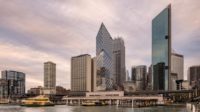Pittsburgh, Pennsylvania
At 33 stories and about 550 feet, PNC Financial Services Group's new headquarters in Pittsburgh will not break any records for its height. But when the under-construction, $400 million building designed by Gensler is completed in the summer of 2015, it will be among a handful of naturally ventilated office towers in the U.S. And it is expected to be the country's tallest tower relying on such a passive strategy for environmental control.
The scheme's key feature is a solar chimney comprising two shafts at the core of the building's trapezoidal floor plate. It will create a 'controlled' stack effect to draw hot air out of the building, according to Denzil Gallagher, principal at Buro Happold, the skyscraper's structural and mechanical engineer. At the top is a 5,000-square-foot chamber with a glass roof and a concrete slab, sloped and angled toward the south in order to trap solar radiation. During much of the spring and fall, when temperatures are mild and humidity is low, this configuration will create a pressure differential that should pull outdoor air through the operable facade and the 30-inch cavity it defines; the air will be drawn across the floor plates, and then vented through the solar chimney. In the winter, the chamber will help preheat fresh outdoor air before its distribution throughout the tower.
To make sure the air would keep moving through the building, but flow slowly and gently, the project-team members built an approximately 5-by-5-foot mockup of the glass-topped chamber on the roof of another PNC-owned building near the site. With the mockup, they recorded factors like air and surface temperatures inside the chamber in order to calibrate their computational fluid dynamics (CFD) studies and energy models. The ultimate goal of this process was optimization of the solar chimney's size and shape.
Consultants predict that the natural ventilation, along with features like active chilled beams, efficient lighting, and automated shades, will produce a skyscraper that exceeds LEED Platinum requirements. And they estimate that the tower will consume only about half the energy of a building that complies with the 2007 version of the ASHRAE 90.1 standard.
But conserving energy is not the only objective. PNC, which has about 160 LEED-certified facilities nationwide, hopes the tower will provide a comfortable working environment. For example, its employees will be able to enjoy views over the city from the multistory atriums, or 'sky gardens,' that make up the tower's west facade and provide space for informal meetings. They will also be able to open sliding windows on the building's interior skin to let the air circulating within the curtain-wall cavity into the office spaces. Even though the tower will rely on passive ventilation for much of the time, points out Ko, the occupants' relationship with the structure will be an active one.
People
Owner:
Architect:
Personnel in architect's firm who should receive special credit: Interior designer: Gensler Engineer(s): Buro Happold
Consultant(s):
Other: General contractor: PJ Dick Renderer(s): Light CG, Tangram 3D S CAD system, project management, or other software used: Revit Gross square footage: 800,000 square ft Cost: $400 million Completion date: 2015 |
Products
Structural system Curtain wall: Permasteelisa GlazingGlass: PPG Industries ConveyanceElevators/Escalators: Schindler
Energy |










